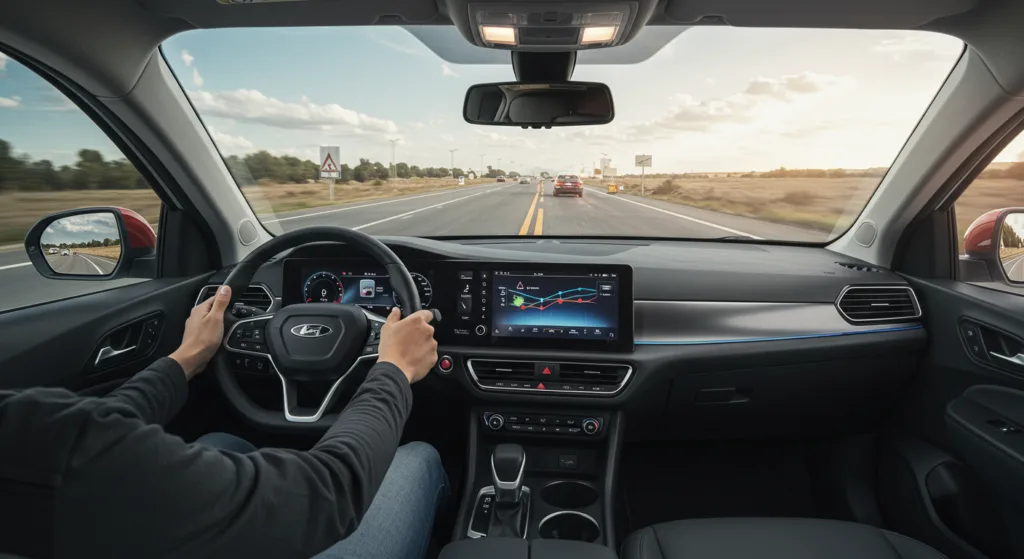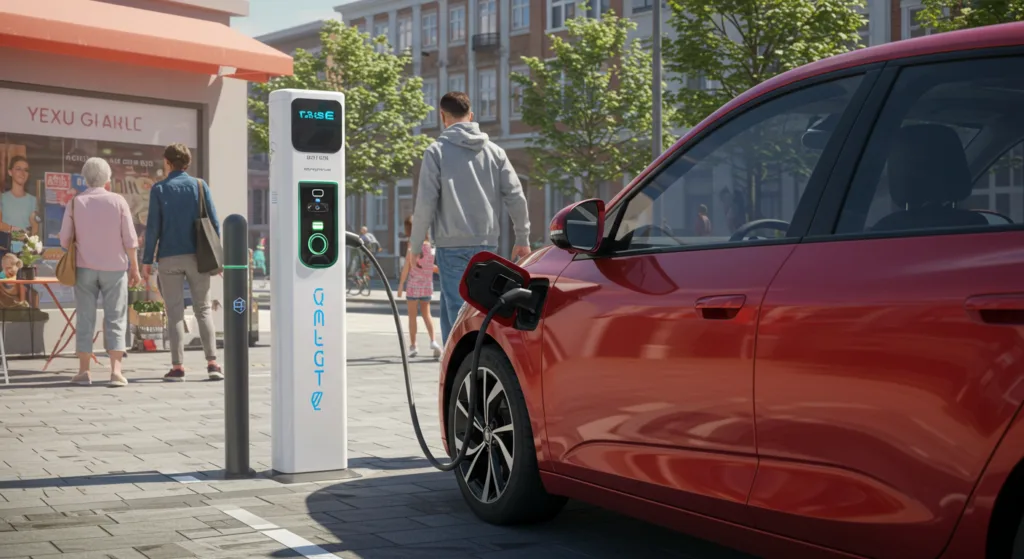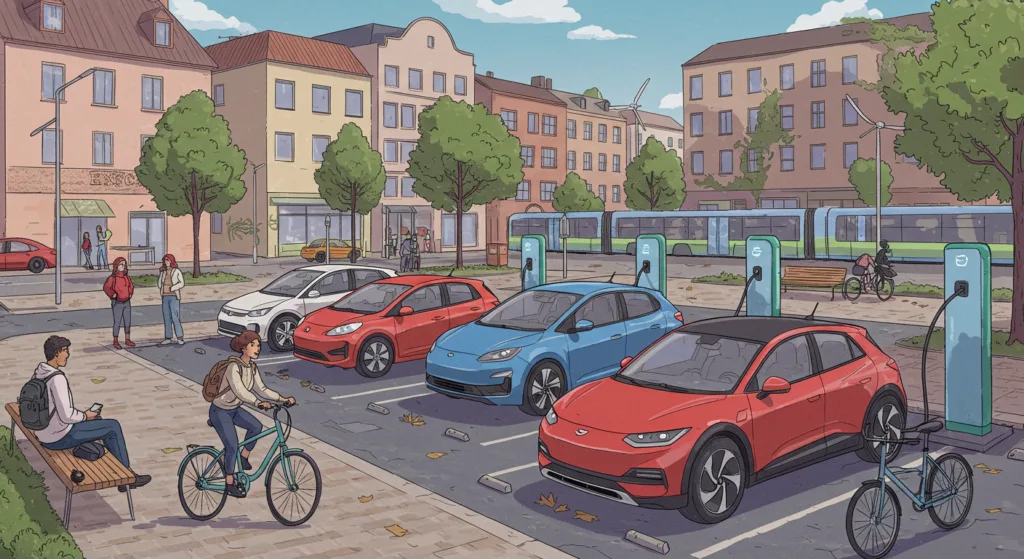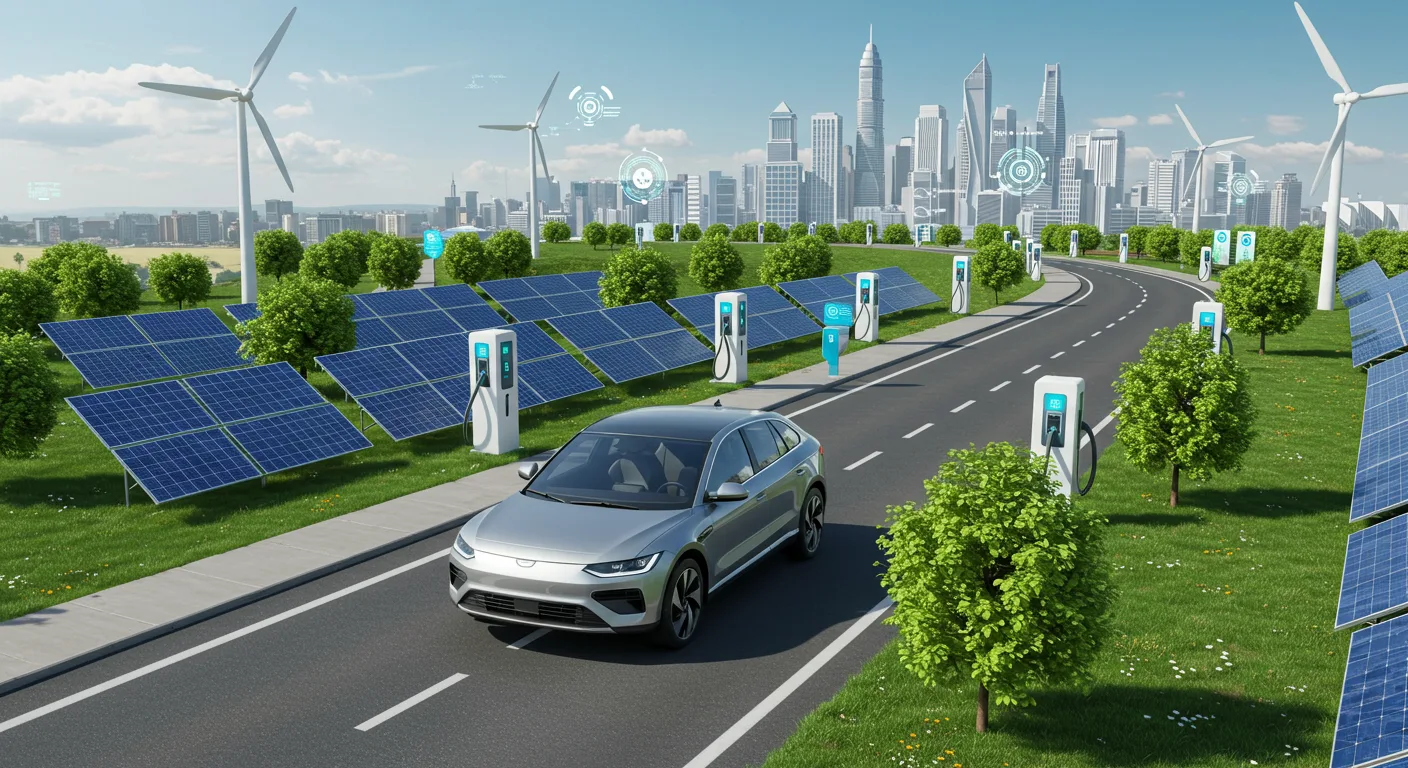Unexpected Perks of Driving an Electric Car (EV) Beyond Cost Savings

Switching to an electric car (EV) is often seen as a way to save money on fuel and maintenance, but the benefits go far beyond just cost savings. Many drivers don’t realize how much EVs can improve their daily lives, contribute to a healthier environment, and even boost their well-being. Let’s explore some of the lesser-known perks of driving an EV.
How EVs Improve Your Daily Driving Experience
Many people assume EVs are just about energy efficiency, but they also enhance your overall driving experience in ways traditional cars can’t. From smoother rides to cutting-edge technology, here’s how EVs make daily commutes more enjoyable:
1. Instant Acceleration and a Smooth Ride
EVs deliver torque instantly, meaning you get rapid acceleration without the delay of a traditional gas engine. Whether you’re merging onto a highway or overtaking another vehicle, the immediate power makes for a smoother and more responsive drive.
- Tesla Model S Plaid goes from 0-60 mph in just 1.99 seconds, making it one of the fastest production cars in the world.
- No gear shifts mean zero jerks or lag, giving you a seamless driving experience.
2. Whisper-Quiet Operation
One of the most surprising perks of EVs is how quiet they are. Without a combustion engine, road noise is significantly reduced, creating a more peaceful cabin environment.
- Noise pollution in urban areas has decreased by up to 10 dB in cities with higher EV adoption rates.
- Less vibration leads to a more relaxing drive, reducing fatigue on long trips.
3. Smart and Intuitive Technology
EVs are built with next-gen tech that enhances convenience and safety:
- Regenerative braking helps recharge the battery while driving, increasing efficiency.
- One-pedal driving simplifies traffic navigation by allowing drivers to slow down or stop without using the brake pedal.
- Over-the-air updates keep your car’s software up-to-date without needing a dealership visit.
The Environmental Impact of EVs You Might Not Know
While EVs are known for reducing carbon emissions, their impact on the environment extends far beyond that. Many eco-friendly features of electric cars are not widely discussed, but they play a crucial role in sustainability.
1. Lower Lifetime Carbon Footprint
While manufacturing an EV battery generates more emissions than producing a gas-powered car, EVs quickly offset that impact.
- According to the International Energy Agency (IEA), EVs produce 50-70% fewer emissions over their lifetime compared to internal combustion engine (ICE) vehicles.
- Studies show that in countries like Norway, where 90% of electricity comes from renewables, EVs reduce emissions by up to 99% compared to gas cars.
2. Reduced Air Pollution and Cleaner Cities
One of the biggest environmental benefits of EVs is the dramatic reduction in air pollution. Gasoline and diesel vehicles emit nitrogen oxides and particulate matter, which contribute to respiratory diseases.
- The American Lung Association estimates that switching to all-electric transportation could prevent 6,300 premature deaths annually in the U.S. alone.
- In London, the adoption of EVs has contributed to a 29% reduction in NO₂ emissions since 2016.
3. Sustainable Battery Recycling and Second-Life Uses
Critics often argue that EV batteries are harmful to the environment, but advancements in battery recycling are proving otherwise:
- 80% of an EV battery’s materials can now be recycled, including lithium, cobalt, and nickel.
- Companies like Redwood Materials are repurposing old EV batteries into new ones, reducing waste and reliance on mining.
- Some used EV batteries are repurposed for grid storage, helping store renewable energy from wind and solar farms.
Hidden Health Benefits of Switching to an Electric Car
Beyond the environmental impact, EVs also offer health benefits that most drivers don’t think about. From cleaner air to lower stress levels, here’s how driving an EV can improve well-being.
1. Reduced Exposure to Airborne Pollutants
Gas-powered cars emit pollutants like carbon monoxide (CO), nitrogen dioxide (NO₂), and particulate matter (PM2.5), which are linked to respiratory and cardiovascular diseases.
- A 2023 Harvard study found that communities with higher EV adoption saw a 30% reduction in asthma-related ER visits.
- In cities where EV adoption exceeds 20%, PM2.5 levels have dropped by an average of 15%.
2. Lower Noise Pollution, Better Mental Health
Noise pollution is often overlooked, but it has a direct impact on stress levels and mental health.
- Studies show that exposure to high traffic noise increases the risk of hypertension and heart disease by 12%.
- EVs, which operate at significantly lower noise levels, contribute to quieter urban environments, reducing stress and improving sleep quality.
3. Less Driving Fatigue and Cognitive Load
Driving an EV requires less effort than a gas-powered car, especially in stop-and-go traffic. Features like one-pedal driving and regenerative braking reduce physical strain, leading to:
- 20% reduction in driver fatigue, according to research by the University of California, Berkeley.
- Lower stress levels, thanks to instant torque and smoother acceleration, eliminating the need for constant gear shifting.
EVs offer far more than just savings on gas—they enhance your daily driving experience, reduce environmental impact, and even improve personal health. Whether it’s the instant acceleration, the peaceful ride, or the long-term benefits of cleaner air, driving an EV is a game-changer in more ways than one.
💡 Plan your charging stops ahead of long trips to ensure a seamless journey. Use apps like PlugShare or Tesla’s Supercharger network to locate fast-charging stations along your route.
How Driving an EV Enhances Your Lifestyle and Convenience

Owning an electric car(EV) isn’t just about cutting fuel costs—it’s about transforming your entire driving experience. EVs provide greater reliability, a more comfortable and peaceful ride, and cutting-edge technology that makes every trip more enjoyable. Let’s explore how switching to an EV can significantly improve your daily life.
Why EVs Are More Reliable Than Gas-Powered Cars
Reliability is one of the key factors when choosing a vehicle, and EVs outperform traditional gasoline cars in several ways. With fewer moving parts and simpler mechanics, EVs reduce the chances of breakdowns and expensive repairs.
1. Fewer Components, Less Maintenance
A gasoline car has over 2,000 moving parts in its engine and transmission, while an EV has around 20. This drastic reduction means fewer parts can fail, making EVs inherently more reliable.
- No oil changes – EVs don’t require engine oil, spark plugs, timing belts, or fuel filters, eliminating routine maintenance.
- Regenerative braking extends brake life – Because EVs use regenerative braking, brake pads and discs wear out much slower, sometimes lasting twice as long as those in gas cars.
- Battery longevity – Modern EV batteries last 200,000 to 500,000 miles, with Tesla’s CEO Elon Musk even predicting future batteries could last 1 million miles.
2. Reduced Risk of Breakdowns
Traditional gas-powered cars suffer from engine failures, fuel system issues, and overheating. With an EV, you avoid common problems like:
- Fuel pump failures – Since EVs don’t use gasoline, there’s no need for fuel pumps or injectors.
- Exhaust system problems – No mufflers, catalytic converters, or emissions-related breakdowns.
- Transmission failures – Most EVs have a single-speed transmission, reducing the risk of costly transmission repairs.
3. Higher Reliability Ratings
According to Consumer Reports, EV owners report 60% fewer powertrain-related issues compared to gasoline car owners. Major brands like Tesla, Hyundai, and Nissan have some of the highest reliability ratings in the industry.
With fewer maintenance requirements and a lower chance of breakdowns, EVs provide a worry-free ownership experience that gas-powered cars simply can’t match.
The Comfort and Quiet Ride That Improves Your Well-being
One of the biggest surprises for new EV owners is just how comfortable and peaceful their drive becomes. From reduced noise levels to smoother acceleration, EVs prioritize driver and passenger well-being in ways that traditional cars cannot.
1. Ultra-Quiet Operation for a Stress-Free Drive
Unlike internal combustion engines, which generate 70-80 decibels of noise, EVs operate at around 40 decibels—similar to a quiet library. This significantly reduces noise pollution, making urban environments quieter and long drives more relaxing.
- In a study by the World Health Organization (WHO), exposure to traffic noise above 55 dB increased stress and sleep disturbances by 30%.
- EVs eliminate engine vibrations, reducing driver fatigue and creating a more enjoyable ride.
2. Smooth and Instant Power Delivery
Electric motors provide instant torque, meaning EVs accelerate smoothly without the jerks and gear shifts of gasoline cars.
- 0-60 mph in under 3 seconds – Many EVs, including the Tesla Model S Plaid and Porsche Taycan Turbo S, can accelerate faster than high-performance gas cars.
- No transmission delays – A single-speed gearbox means no sudden shifts or lags in power delivery.
3. Spacious and Ergonomic Interior Design
With no bulky engine or transmission tunnel, EVs offer more interior space than traditional cars:
- Flat floors allow for larger legroom, making back seats more comfortable.
- Frunk (front trunk) storage provides extra space for luggage and groceries.
- Climate-controlled battery systems keep cabin temperatures stable in extreme weather, enhancing comfort year-round.
Whether you’re commuting to work or going on a road trip, the quiet, smooth, and spacious nature of EVs makes every journey more enjoyable and stress-free.
Smart Technology Features That Make EVs More Enjoyable
EVs aren’t just more efficient—they also come with some of the most advanced technology on the market, designed to make driving easier, safer, and more entertaining.
1. Advanced Driver Assistance Systems (ADAS)
Most EVs come equipped with cutting-edge safety features that enhance driver confidence and reduce accidents:
- Autopilot and Full Self-Driving (FSD) – Tesla leads the industry with semi-autonomous driving features.
- Adaptive Cruise Control (ACC) – Maintains a safe distance from the car ahead and adjusts speed accordingly.
- Lane Keep Assist (LKA) & Emergency Braking – Helps prevent collisions and keeps the car centered on highways.
According to the National Highway Traffic Safety Administration (NHTSA), ADAS features in EVs have reduced accidents by up to 40%.
2. Over-the-Air (OTA) Software Updates
Unlike gas cars, which require visits to the dealership for upgrades, EVs receive regular software updates just like a smartphone.
- Performance enhancements – Some updates increase horsepower or battery efficiency.
- New features added – Tesla, for example, has introduced entirely new driving modes through OTA updates.
- Bug fixes and security patches – Ensuring long-term vehicle reliability.
3. Intuitive Infotainment Systems
EVs come with some of the most interactive and high-tech infotainment systems available:
- Large touchscreen displays – Tesla’s 17-inch center screen is one of the most advanced in the industry.
- Integrated voice control – Activate navigation, adjust climate settings, and make calls hands-free.
- Streaming and gaming – Some EVs allow you to watch Netflix, play video games, or browse the internet while charging.
4. Smart Charging and Remote Monitoring
EV owners can control and monitor their car directly from their smartphone:
- Set charging schedules – Charge at off-peak hours to save money.
- Pre-condition cabin temperature – Heat or cool the car before you even step inside.
- Track range and battery status – Always know how much charge you have left.
EVs are more than just fuel-efficient vehicles—they enhance comfort, reliability, and driving convenience in ways that gasoline cars simply can’t compete with. Whether it’s the near-silent ride, futuristic technology, or hassle-free maintenance, EVs make every day driving an experience rather than just a necessity.
🚗⚡ “The electric car is not just a revolution in transportation; it’s a revolution in how we think about energy and sustainability.” – Elon Musk
The Social and Community Benefits of Owning an EV

Electric car (EVs) aren’t just a personal upgrade; they’re a community-wide transformation. Owning an EV goes beyond saving money—it contributes to a cleaner environment, supports local sustainability initiatives, and brings new opportunities for travel and public infrastructure. As the EV industry grows, so do the benefits for entire communities, making cities and towns more livable, efficient, and eco-friendly.
How Electric Car Adoption Supports Local Sustainability Efforts
When more people switch to electric car , it creates a ripple effect that benefits entire communities by reducing pollution, encouraging green energy use, and supporting local sustainability projects.
1. Lowering Urban Air Pollution and Public Health Benefits
Gas-powered vehicles are the largest source of urban air pollution, releasing nitrogen oxides (NOx) and particulate matter (PM2.5) that contribute to respiratory diseases. By switching to EVs, cities experience:
- Up to 30% lower asthma rates in high-EV-adoption areas, according to a study by the American Lung Association.
- Reduced hospital visits for respiratory and cardiovascular diseases, as seen in Norway, where high EV adoption has led to cleaner urban air.
2. Supporting Renewable Energy Growth
EVs are not just about reducing tailpipe emissions—they also encourage investment in clean energy infrastructure:
- Many EV owners charge their cars using solar panels at home, reducing dependence on fossil fuels.
- Cities with high EV adoption rates tend to see faster investments in renewable energy, as utility companies adapt to increased electricity demand.
For example, in California, where over 1.5 million EVs are on the road, utilities are rapidly expanding their wind and solar power capacity to meet demand, accelerating the clean energy transition.
3. Incentivizing Green Urban Planning
Cities with growing EV ownership are adapting by implementing EV-friendly policies, such as:
- Dedicated EV parking spots with free charging in commercial and residential areas.
- Carpool lane access for EV drivers, reducing traffic congestion.
- Low Emission Zones (LEZs) where EVs can drive freely while gas-powered vehicles face restrictions or higher tolls.
These policies encourage more people to adopt EVs and push cities to invest in cleaner, more sustainable transportation solutions.
The Growing Charging Network and Its Advantages for Road Trips
A common concern about EVs is charging availability, but the charging infrastructure is expanding faster than ever, making long-distance travel easier and more convenient.
1. Rapid Expansion of Public Charging Stations
Governments and private companies are aggressively expanding charging networks worldwide:
- As of 2024, the U.S. has over 160,000 public charging stations, a 200% increase from 2020.
- The EU plans to install 1 million charging stations by 2030, ensuring coverage in urban and rural areas.
- Tesla’s Supercharger network has grown to over 50,000 chargers globally, allowing EVs to charge up to 80% in 15-30 minutes.
2. Fast-Charging Technology for Road Trips
EVs are now more road-trip-friendly than ever, thanks to high-speed charging innovations:
- Ultra-fast DC chargers (like those from Electrify America and Ionity) can deliver up to 350 kW, adding 250+ miles of range in under 20 minutes.
- Many charging stations are now located at restaurants, shopping centers, and rest areas, making stops more convenient and enjoyable.
For example, Rivian’s Adventure Network is building chargers along off-road and scenic routes, enabling electric road trips in remote locations.
3. Smart Charging for Hassle-Free Travel
EV charging is becoming smarter and more seamless:
- Apps like PlugShare, ChargePoint, and Tesla’s Navigation System help drivers locate chargers in real time.
- Plug & Charge technology allows EVs to start charging instantly without using a credit card or app.
- Pre-planned route optimization ensures drivers always have charging stops along their journey.
With these advancements, taking an Electric Car on a road trip is now easier than ever, eliminating range anxiety and making electric travel a realistic option.
How EV Incentives and Perks Extend Beyond Just Tax Credits
While most people know about government tax credits for EVs, there are many other financial and lifestyle perks that come with owning an electric car.
1. Lower Ownership Costs Beyond Fuel Savings
EVs not only eliminate gas expenses but also provide savings in other ways:
- Reduced maintenance costs – EVs have 50% fewer maintenance expenses compared to gas cars due to fewer moving parts.
- Lower insurance rates in some states – As EVs become more mainstream, insurance companies are offering competitive rates for electric cars.
- No emissions testing fees – EV owners avoid costly emissions inspections required for gasoline vehicles.
2. Exclusive Driving Perks and Benefits
Many cities and states offer exclusive benefits to Electric Car drivers:
- Free or discounted tolls – Some regions, like California and Florida, offer free express lane access for EVs.
- Reserved parking with free charging – Many businesses, shopping malls, and airports provide priority parking for EVs.
- Discounted registration fees – Some states, like Colorado and New York, offer lower annual registration costs for EVs.
3. Business and Workplace Incentives
EV adoption isn’t just benefiting individuals—businesses are also incentivizing employees to go electric:
- Many companies now offer EV purchase subsidies for employees, covering part of the cost.
- Workplace charging stations are becoming common, allowing employees to charge their cars for free or at reduced rates.
- EV-friendly corporate fleets – Companies like Amazon, FedEx, and Walmart are transitioning to electric delivery vehicles, reducing business carbon footprints.
With incentives beyond tax credits, owning an EV is more financially and practically rewarding than ever.
Electric cars are not just personal assets—they’re transforming entire communities. As more people make the switch, local economies, public health, and infrastructure all benefit. From sustainability initiatives to expanded charging networks and exclusive perks, EVs are shaping the future of transportation in ways that go far beyond individual savings.
Owning an electric car (EV) goes beyond just saving money on fuel—it enhances your daily driving experience, contributes to a cleaner environment, and comes with exclusive perks that make life more convenient. From quieter rides and advanced technology to expanding charging networks and sustainability benefits, EVs are shaping the future of transportation.
🔋 Every time you drive electric, you contribute to cleaner air and a greener future. Even small steps—like choosing public EV chargers powered by renewable energy—make a big impact. 🌱♻️
If you found this article helpful, share it on social media and help others discover the hidden benefits of driving an EV! 🚗⚡



